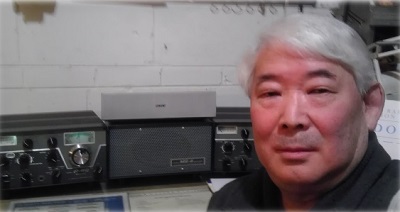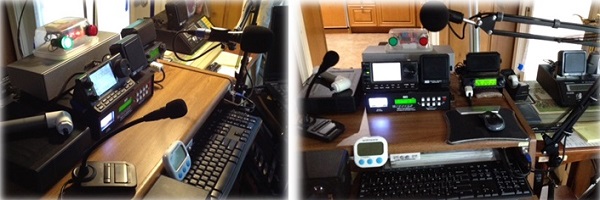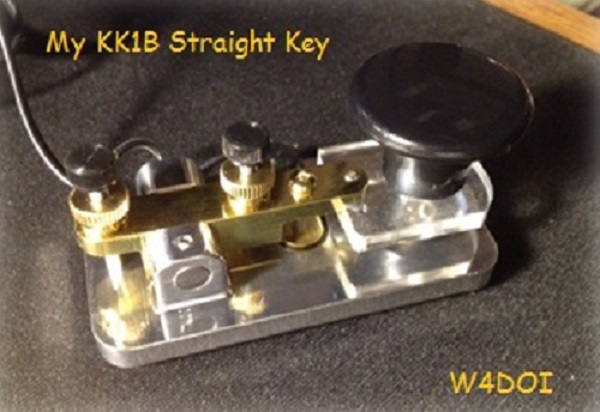 |
W4DOI Alan J. Doi Alexandria, VA QCWA # 37126 Chapter 91 |
COUNTY: Alexandria City // GRID SQUARE: FM18LT
HF: ICOM-7100 - 100-watts - 135' doublet 160-10m windowline-fed multiband via MFJ-993B autotuner
VHF: ICOM-2300h 2m FM - 5/10/25/65-watts - 2-element homebrew yagi indoors
VHF/UHF: ICOM-7100 All-mode - 50w 2m VHF/35w 440mhz UHF - Hentenna homebrew @ 15'
VHF/UHF HANDHELD: BAOFENG 2m/440mhz - UV-82 1&5-watts & UV-B5 2&5-watts
My amateur radio story seems to be a familiar one these days. After almost 30 years away from the hobby, retirement has brought me back to the ranks of active licensed amateur radio operators. First licensed in 1965 as a 5wpm Novice after discovering the high school radio club. Back in those days, the Novice license was for a one-year non-renewable term and in the HF bands restricted to CW on small segments of the bands using crystal-controlled transmitters and a max of 75-watts input power, yes, input power. Made for interesting operating experience as the typical novice-to-novice QSO was a split-frequency affair since we almost never had a crystal for the same frequency. I operated in the club shack after school almost every afternoon for an hour or two using a Heathkit DX-20 transmitte, a National HRO-50T receiver, and a dipole antenna.
Soon after the novice expired, I made my way to the Los Angeles FCC office to take the 13wpm Code and General Theory exam. I passed and received my new call, WB6VLM. It wasn't long after getting my General ticket that the club upgraded its General station to brand new Drake equipment consisting of a T-4X transmitter, an R-4A receiver, and an L-4B amplifier along with a 40' tower topped with a new Hy-Gain TH6DX beam. Of course, as a young high school student, it was a few years before I understood and appreciated how spoiled I had been operating that station. Once I went off to college, there was no ham club and with all the distractions of college life, I slowly fell away from the hobby and my licensed expired. I was commissioned into the US Air Force upon graduation and went right off to pilot training. It was around this time that I developed an interest in the emerging world of microcomputers as they were called then. I spent about 22 years serving in the Air Force and, for most of that time, my "office" was in the type aircraft in the photos below -- interestingly, this aircraft was equiped with an HF SSB radio that we used every mission to send and receive messages and other misc operating like phone patches back to the home base. Had I been licensed at the time, I probably would've investigated making a ham contact while airborne - an opportunity lost!

About halfway through my air force career while stationed in Michigan, I heard about a Novice class that was about to start. I was ready to ease back into ham radio and signed up and passed the exam receiving KA8UCX. This was the 5wpm Novice and about the same theory exam that I remembered but now Novices could use up to 200-watts input and VFOs. Coincidentally, there was another ham in the same unit that was selling his Drake C-Line pair - a T-4XC, an R-4C, and the matching MS-4 speaker that held the transmitter's power supply. It brought me back to my early days of operating the club station and I immediately purchased them. That's the equipment pictured at the top of the page which I still have and likely always will. The new Novice license was now good for 2-years and renewable. It was about this same time that Novice enhancement was put in place which gave Novices SSB privileges on 10-meters. Within months of receiving my new call, I was re-assigned to California. Once I got moved and settled, I put up a ten-meter dipole. I made many contacts, it was a good period in the sunspot cycle and the band was full of activity. Another few years and another re-assignment to Nebraska. The new job was time consuming and kept me off the air as I fell away from the hobby again. One more move and new assignment to Virginia then my time in the Air Force came to an end. After training and certification, I started a new career in the world of computer data networks as a network engineer - the information superhighway was just opening up as the internet was becoming mainstream with all sizes of businesses putting in data networks - nothing better than good timing.
Which leads me to now... last summer I entered the ranks of the retired and upon doing so, I decided I wanted to get back into the hobby. I researched the current licensing process finding out that the code requirements were gone, the question banks were published, and the exams were given by VECs. And then I found out that there would be exams given in two-weeks at a location less than a mile from my home. It didn't take me long to decide to study for two weeks and take the Tech exam. The material was still very familiar and being retired allowed me to devote study time every day. With that license behind me, I learned that the same Mount Vernon Amateur Radio Club VEC team gave exams monthly. So, I decided to study for a month and attempt the General and Extra exams. The General material also was still very familiar, the Extra material required most of my time and effort since much of it was new and/or more in-depth. I successful passed both exams the next month. It was about that time that the FCC dropped the charges for Vanity Calls and with their online system, the process was much easier and streamlined. I had already decided I wanted to get a shorter call and one in the call area where I was living, thus the W4DOI.
I dusted off the old equipment.... the Drake station. The receiver still functions nicely but I hestitated to power up the transmitter. I have been warned that the caps may have all dried out and may blow the first time they are powered up and possibly take the power transformer with them -- the cap replacements are available but the transformer is more difficult to replace. So, I started listening to the HF bands with the R-4C to re-familiarize myself with operating practices and propagation. I also dusted off an old Radio Shack scanner and programmed the local repeater frequencies to find out what VHF/UHF was all about. I had never operated up there in the past.
After pondering what to do about the Drake transmitter, I decided the best thing to do was to get something new first then work on the Drake later. I need something reliable as I start operating again and have the Drake equipment available as a backup station or more accurately a "nostalgic" station to occasionally operated for the fun of it. So, I began my search of new equipment which was a bit overwhelming with the myriad of equipment and price ranges available now. First, I acquired an Icom 2300h 2-meter transceiver so I could begin using local repeaters. Along with that were two Baofeng dual-band HTs just because they were so cheap and would give me 440mhz capability.... I had very low expectations but I have been surprised at how well they work for casual use and how full-featured they are at that price, each was just under 30 dollars a piece, amazing. I call them my "pizza" radios since right after I got them, I happen to order a large pizza plus some sides from Domino's and by the time I tipped the driver, the price came to almost what I paid for one of the Baofeng HTs!
For my HF radio, I decided on one of the Shack-in-a-box / DC-to-Daylight radios to fulfill my desire for an all-purpose radio. I chose the Icom 7100 - it met my all-purpose wishlist covering 160m thru 440mhz (sans 220mhz) plus had D-star which I thought I should dabble in. I knew any radio of this type would have compromises but I also figured that it won't be too long before I would have a dedicated HF radio and the 7100 would make a good all-purpose backup radio plus all-mode VHF/UHF radio plus portable/mobile radio. As you can see in the photos below, this combination of radios makes for a very compact base station setup for now. I used an old computer table for the radios. Very small footprint especially with the 7100 control head sitting on the MFJ 993B autotuner which puts all the meters from the radio and the tuner right in front of me. There is a Heil HM-IC mic on a boom for the VHF FM radio and an Icom SM30 deskmic for the 7100.

When I decided on the 7100 I was a bit skeptical about the whole touch screen aspect of this radio. But, now I can say it has been a joy to operate. It is nice having such a minimal looking radio and yet have easy access via touch to all the operating parameters I normally use as well as the settings that are only used infrequently. I marvel at how much radio and features they have packed into such a small package.
I am reminded every day about all the aspects available to explore in this amateur radio hobby. So many new things to dabble in and yet so much is still familiar. I have enjoyed getting back on the HF bands using a multi-band, window-line fed 135' doublet wire antenna tuned with the autotuner. I have already experimented with several HF antennas...dipoles, a full wave horizontal loop, and end fed wires. Built a two-meter Hentenna and also a 2-element two-meter yagi, both out of half-inch copper pipe. My first foray into VHF operating on a local repeater has been very positive, meeting many wonderful people on the air. I am looking forward to exploring more aspects of the hobby.
Postscript: The latest station addition is shown in the photo below....yes, what's old is new again. Starting my "study" to get back into CW. They say that CW is good exercise for the brain and after my first attempts in a long time at copying code, I can vouch for that! I'm hoping that the mental exercise of CW will clear out some of the cobwebs and establish some new "connections" in this old brain. My KK1B, in the photo below, is a small straight key that is purchased as a kit thru easy online ordering. Quick shipping. Easy assembly &lessthan; 30-min. I polished the aluminum-base and brass components with a dremel-tool using polishing "wheels" and polishing compounds to give it a nice shine.

STRAIGHT KEY KIT BY
American Morse Equipment - San Luis Machine Company
San Luis Obispo, California
July 05, 2016